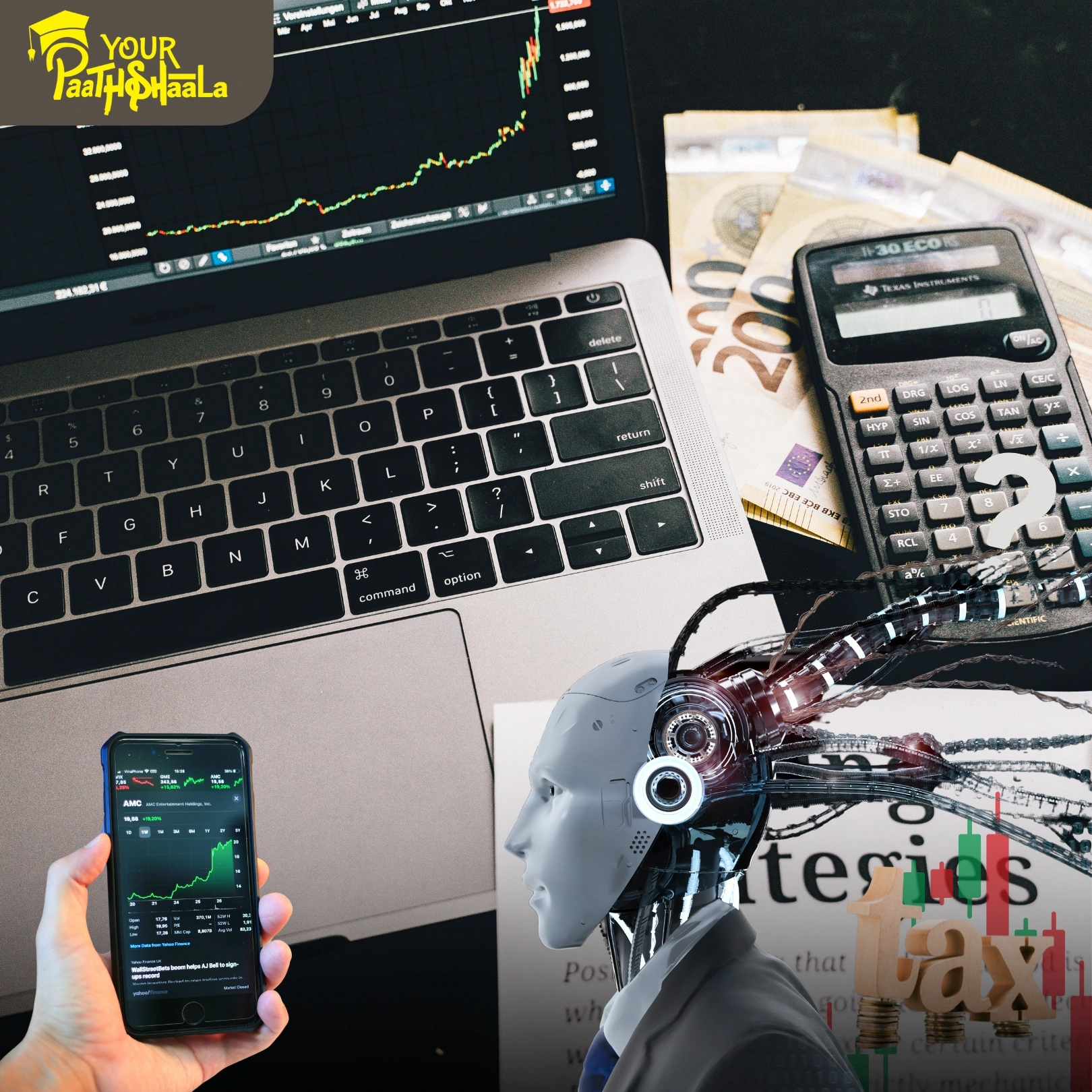The Rise of AI in Stock Trading: Everything You Need to Know

Artificial intelligence (AI) is no longer just a buzzword; it’s a force reshaping industries across the globe. The financial sector, especially stock trading, is experiencing a profound transformation thanks to AI. While human expertise remains essential, AI in stock trading is taking on an increasingly significant role. AI excels at analyzing vast datasets, identifying hidden patterns, and executing trades with speed and precision that humans simply can’t match.
The numbers speak volumes. In 2023, the global AI trading market reached a valuation of $18.2 billion. Projections indicate that this market could nearly triple by 2033! This rapid growth highlights the immense potential and increasing adoption of AI in stock trading.
So, how exactly is AI changing the game? What tools are driving this revolution? And what are the potential benefits and risks that investors need to consider? Let’s take a closer look.
Understanding AI in Stock Trading: A Broad Overview
AI in stock trading refers to the use of artificial intelligence, predictive analytics, and machine learning to analyze historical market data, generate investment ideas, construct portfolios, and automatically execute buy and sell orders for stocks.
Think of AI as a sophisticated assistant that can process massive amounts of information far more quickly and efficiently than a human. It can identify subtle trends, predict market movements, and make data-driven decisions to optimize trading strategies.
How AI in Stock Trading Works: A Step-by-Step Process
AI in stock trading involves a series of interconnected steps. Let’s break down the process:
1. Data Acquisition: Gathering the Building Blocks
The first crucial step is collecting vast amounts of relevant data. This data forms the foundation for AI’s analysis and decision-making. Sources include:
Historical stock prices: Past performance is a key indicator.
Financial news articles: News sentiment can influence stock prices.
Social media data: Public opinion can provide valuable insights.
Economic indicators: Factors like GDP and inflation impact markets.
2. Data Preprocessing: Cleaning and Organizing the Information
Raw data is often messy and needs to be cleaned and organized before it can be used effectively. This involves:
Removing errors and inconsistencies.
Converting data into a usable format.
Feature engineering: Creating new data points that highlight important relationships.
3. Pattern Recognition: Uncovering Hidden Connections
Once the data is preprocessed, AI algorithms can analyze it to identify patterns and relationships that humans might miss. This is where machine learning comes into play.
Machine learning algorithms learn from the data.
They identify correlations and predict future outcomes.
Examples include neural networks and support vector machines.
4. Prediction and Strategy Development:
Based on the identified patterns, the AI develops predictions about future market movements. It then uses these predictions to create trading strategies designed to maximize profits and minimize risk.
5. Trade Execution: Putting the Plan into Action
Once a trading strategy is developed, the AI can automatically execute trades through a brokerage platform. This allows for rapid and efficient execution of trades based on real-time market conditions.
6. Monitoring and Optimization: Continuous Improvement
AI in stock trading is not a “set it and forget it” solution. The AI continuously monitors the market and adjusts its strategies as needed to adapt to changing conditions. This iterative process ensures that the AI remains effective over time.
Different Types of AI Trading Strategies
AI in stock trading isn’t a one-size-fits-all approach. There are several different types of AI trading strategies, each with its own strengths and weaknesses:
Quantitative Trading (Quant Trading): Math-Driven Investing
Quantitative trading, often called “quant trading,” uses mathematical models and statistical analysis to identify trading opportunities. Quants develop complex algorithms that analyze price and volume data to find profitable patterns. This approach is often used for large-scale transactions.
Algorithmic Trading (Algo-Trading): Rule-Based Automation
Algorithmic trading, or “algo-trading,” involves using computer programs to execute trades based on a predefined set of rules. These rules might be based on technical indicators, fundamental analysis, or other factors. Algo-trading allows for automated execution of trades, reducing the need for human intervention.
High-Frequency Trading (HFT): Speed and Agility
High-frequency trading (HFT) is a type of algorithmic trading characterized by extremely high speeds and short holding periods. HFT firms use sophisticated technology to analyze market data and execute trades in milliseconds, taking advantage of tiny price discrepancies.
Automated Trading: Simplifying the Process
Automated trading uses pre-programmed instructions to execute trades. It is similar to algorithmic trading but often operates on more basic trading strategies. Automated trading can be a good option for investors who want to automate some of their trading but don’t have the expertise to develop complex algorithms.
Arbitrage Trading: Exploiting Price Differences
Arbitrage trading involves exploiting price differences for the same asset in different markets. AI in stock trading tools can monitor multiple markets simultaneously, identifying these discrepancies and executing trades to profit from them.
Powerful AI Trading Tools
When it comes to AI in stock trading, investors have a growing arsenal of tools at their disposal:
AI Portfolio Managers: Automated Investment Solutions
These tools autonomously select assets to create a portfolio and then monitor it, adding and removing assets as needed. Investors can input their financial goals and risk tolerance to inform the AI’s decisions.
Trading Robots: Automated Trading Assistants
AI-powered trading robots are software programs that make trading decisions based on predetermined rules. They can analyze market data, identify trading opportunities, and execute trades automatically.
AI Signals: Real-Time Trading Alerts
AI signals are pre-programmed to send automatic alerts when they discover stocks that meet specific criteria. These signals can help investors identify potential trading opportunities quickly and easily.
Strategy Builders: Custom Trading Strategies
Strategy builders are AI tools that allow investors to design custom trading strategies. Investors can backtest their strategies using historical data to see how they would have performed in the past.
The Many Uses of AI in Stock Trading
AI in stock trading extends beyond just executing trades. It is valuable throughout the investment process:
Data Mining: Finding Hidden Insights
Data mining involves analyzing massive volumes of data to identify trends and patterns. AI in stock trading can gather historical data and extract insights on past stock market behavior. Investors can then use these insights to make smarter trading decisions.
Sentiment Analysis: Gauging Market Mood
Sentiment analysis goes beyond stock market happenings and analyzes all online financial-related activity, including discussions on social media, news platforms, community forums, and other online spaces. This provides another avenue for investors to gauge market behavior and make educated trading decisions.
Real-Time Analysis: Instant Insights
Real-time analysis is when algorithms analyze data as soon as it is produced to determine market patterns and trends. AI in stock trading tools have the capacity to analyze large amounts of data in real time and generate actionable insights.
Predictive Modeling: Forecasting the Future
Predictive modeling involves collecting past data to anticipate future trends. In AI in stock trading, algorithms can process millions of transactions and analyze this historical data to predict stock market behavior based on previous scenarios.
Risk Modeling: Assessing Potential Dangers
In addition to predictive models, investors can use AI technologies to produce risk models. These types of models weigh the possibilities of different events based on historical data and analysis. Investors can survey these scenarios to gauge how risky an investment is.
Stress Testing: Evaluating Strategy Resilience
Stress testing involves testing an investment strategy on historical data or through a simulation to see how it holds up under various circumstances. Investors can then detect flaws in their strategies and determine steps to strengthen their financial standing.
Backtesting: Refining Strategies with History
Backtesting is the method of testing an investment strategy using historical data before allowing an AI tool to use this strategy to conduct real-world trades. This means having an AI tool apply an investment strategy to virtual capital and assessing the results.
Benchmarking: Measuring Performance
Benchmarking is the practice of evaluating an investment strategy by comparing it to a stock market benchmark or index. AI in stock trading tools can help compare investment strategies to those of other investors or benchmarks in a specific sector or industry.
Benefits of AI Trading
AI in stock trading offers a compelling range of advantages:
Reduced Research Time and Improved Accuracy
AI trading automates research and data-driven decision-making, which allows investors to spend less time researching and more time overseeing actual trades and advising their clients. One survey found that traders who used algorithmic trading increased productivity by 10 percent.
Because AI in stock trading uses historical financial data to inform decisions, there is less risk for human error and more room for accuracy.
Predicting Patterns: Uncovering Market Trends
Using sentiment analysis, which is the process of gathering text and linguistics and using natural language processing to identify patterns within subjective material, an AI in stock trading system can gather information from news outlets and social media to determine market swings and shed light on potential investor behavior.
Stronger Risk Management: Minimizing Losses
AI tools can automate the process of collecting data and building predictive models based on historical data. Investors can then compile insights to weigh the likelihood of various outcomes, assess their current investment strategies, and make changes as needed. For investors who rely on automated investing, AI tools can avoid making emotional decisions and maintain more logical and consistent trading.
Lower Costs: Streamlining Operations
Traditional investment firms might have hundreds of brokers, analysts, and advisors working under them, but AI in stock trading technology can replicate some of the repetitive tasks people have to do. There may be costs to implement and maintain AI, but over time firms and investors can spend less money on overhead expenses. Plus, AI algorithms can work continuously and monitor the stock market.
Risks of AI Trading: Potential Drawbacks
While the advantages are clear, it’s important to acknowledge the risks associated with AI in stock trading:
Less Transparency: The “Black Box” Problem
AI in stock trading technologies can handle thousands and sometimes millions of complex calculations in a matter of seconds. It’s impossible for humans to comprehend this task and understand how AI makes trading decisions. This raises questions about the ethics of using this technology and whether AI tools can be regulated in the stock market.
Over-Reliance on Historical Data: Ignoring New Realities
While using historical data to anticipate future stock market behavior has proven to be an accurate method, it isn’t foolproof. Stock markets can be volatile, and unprecedented events like climate-driven migration and geopolitical conflicts could place new stress on markets. If investors don’t consider this volatility, they could rely too much on historical data when it doesn’t capture the full picture.
Larger-Scale Errors: The Amplification Effect
As investors and institutions strive to become faster traders than their competitors, there are more opportunities for software errors to occur. A line of inaccurate code can spell massive trouble for a firm when that error is multiplied on the scale of hundreds of thousands of trades happening in a split second. If investors plan to automate more of their investment process, they need to ensure their software is bug-free.
Cybersecurity Concerns: Protecting Sensitive Data
AI in stock trading tools can become targets of cyberattacks, and data breaches can lead to concerns around data privacy and financial health. Malicious actors may even take control of AI algorithms to destabilize financial markets and cause widespread confusion. Companies and individual investors would do well to take proper security precautions before embracing AI trading technology.
Conclusion: Embracing the Future of Trading
AI in stock trading is transforming the financial world, offering unprecedented opportunities for efficiency, accuracy, and profit generation. From automated portfolio management to real-time market analysis, the capabilities of AI are revolutionizing how investors approach the market.
However, it’s crucial to remember that AI is not a silver bullet. It’s essential to understand the potential risks and limitations of AI in stock trading before fully embracing this technology. By combining the power of AI with human expertise and sound judgment, investors can navigate the complexities of the market and achieve their financial goals. The future of trading is here, and it’s powered by AI.
Still not get the concept of Stock Trading join YourPaathshaala to gain knowledge from industry experts about stock market from basic to advance contact us for more details on how to join. And go check out the blog page of stockmarketcourseinraipur.in for more insight in Stock Market related information.






